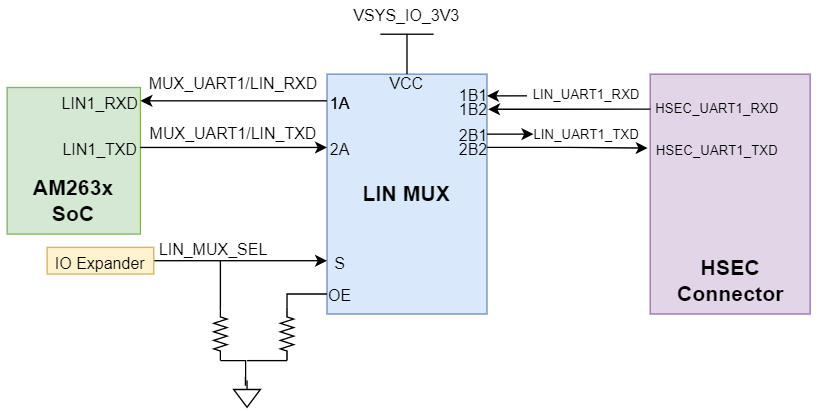SPRUJ09D March 2022 – September 2023 AM2631 , AM2631-Q1 , AM2632 , AM2632-Q1 , AM2634 , AM2634-Q1 , AM263P2-Q1 , AM263P4 , AM263P4-Q1
- 1
- Abstract
- Trademarks
- 1Preface: Read This First
- 2Control Card Overview
- 3Board Setup
- 4Hardware Description
- 5References
- Revision History
- A E2 Design Changes
- B E1 HSEC Pinout Table
4.10 UART
The AM263x Control Card uses the XDS110 as a USB2.0 to UART bridge for terminal access. UART0 transmit and receive signals of the AM263x SoC are mapped to the XDS110 with a dual channel isolation buffer (ISO7221CDR) for translating from the 3.3 V IO voltage supply to the 3.3 V XDS supply. The XDS110 is connected to a micro-B USB connector for the USB 2.0 signals. ESD protection is provided to the USB 2.0 signals by a transient voltage suppression device (TPD4E004DRYR). The micro-B USB connector's VBUS 5 V power is mapped to a low dropout regulator (TPS79601DRBR) to generate the 3.3 V XDS supply. A separate 3.3V supply for the XDS110 allows for the emulator to maintain a connection when power to the Control Card is removed.
 Figure 4-17 UART-USB Bridge for
Emulation
Figure 4-17 UART-USB Bridge for
EmulationThe Control Card supports an additional UART1 instance that has the transmit and receive signals mapped from the AM263x SoC to the HSEC connector. To make use of UART1, the select line of a 1:2 mux must be high. The select line is driven by a GPIO signal (LIN_MUX_SEL) that is sourced from the IO expander.
| Select | Condition | Function |
|---|---|---|
| LOW | LIN Selected | A→B1 |
| HIGH | HSEC UART Selected | A→B2 |
 Figure 4-18 UART 1:2 MUX to HSEC
Figure 4-18 UART 1:2 MUX to HSEC